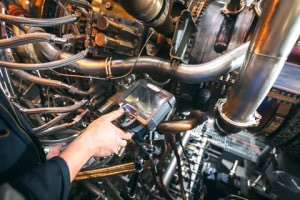This free online course introduces you to the fundamental principles of gas turbine starting systems, as well as their procedures and safety precautions. We break down start-up control features along with the characteristics of electric starters, including new advances to their technology. We explore the functionality and features of General Electric’s starting systems (the engine start, motoring purge, water wash and borescope) before examining pneumatic starters. This course investigates the components of the hydraulic start system and establishes its disadvantages: complexity, system weight, flammability of hydraulic fluids and the existence of high-pressure hydraulic lines. We study hydraulic start-system operation alongside functions of the hydraulic oil charge pump, charge pump filter and main hydraulic oil pump. This includes the hydraulic starter motor, centrifugal starting clutch and pre-start inspection steps.
This course then shows you how to work out much lubricating oil a gas turbine requires and consumes. We compare the two types of lubricating oil for gas turbine applications: standard and corrosion inhibiting. We demonstrate the harsh conditions experienced by lubrication oil in gas turbines: extreme heat, high contamination and inadvertent mixing with other substances. We cover two types of lubrication systems (wet sump and dry sump) while using a lube oil system schematic to explain the lube oil flow and components of the lube oil and lube scavenge subsystems. We lay out the characteristics, requirements, maintenance and handling of fuel before comparing its types: liquified natural gas (LNG), liquified petroleum gas (LPG), ethane and pure hydrogen. After establishing the functions and components of the fuel system, the course teaches you the requirements for a marine gas turbine engine: starting, steady running requirements and engine acceleration and deceleration.
We can help you to master detection methods used for typical transducer faults like speed and temperature transducers. This course also teaches you the spark ignition system’s working features and functions as you become familiar with power turbines and the significance of the synchro-self-shifting (SSS) clutch in starting them up. We unpack epicyclic gears (star, planetary and solar) and demonstrate the advantages of using multiple-planet wheels. We then take you through more clutches: twin-disk, airflex, hydraulic and sprag. We explain the purpose of the ‘bleed air’ and ‘intake and exhaust’ systems before delving into the data-processing aspect of the automated central operating systems (ACOS). This free online engineering course suits anyone interested in the inner workings of gas turbines, particularly those who care about the planet and want to keep it powered with clean energy.
What You Will Learn In This Free Course
View All Learning Outcomes View Less All Alison courses are free to enrol, study, and complete. To successfully complete this Certificate course and become an Alison Graduate, you need to achieve 80% or higher in each course assessment.
Once you have completed this Certificate course, you have the option to acquire an official Certificate, which is a great way to share your achievement with the world.
Your Alison certificate is:
- Ideal for sharing with potential employers.
- Great for your CV, professional social media profiles, and job applications.
- An indication of your commitment to continuously learn, upskill, and achieve high results.
- An incentive for you to continue empowering yourself through lifelong learning.
Alison offers 2 types of Certificate for completed Certificate courses:
- Digital Certificate: a downloadable Certificate in PDF format immediately available to you when you complete your purchase.
- Physical Certificate: a physical version of your officially branded and security-marked Certificate
All Certificate are available to purchase through the Alison Shop. For more information on purchasing Alison Certificate, please visit our FAQs. If you decide not to purchase your Alison Certificate, you can still demonstrate your achievement by sharing your Learner Record or Learner Achievement Verification, both of which are accessible from your Account Settings.











 Avg. Hours
Avg. Hours  Contains Video
Contains Video  CPD Accredited
CPD Accredited 
 Total XP:
Total XP: 
 Knowledge & Skills You Will Learn
Knowledge & Skills You Will Learn 







